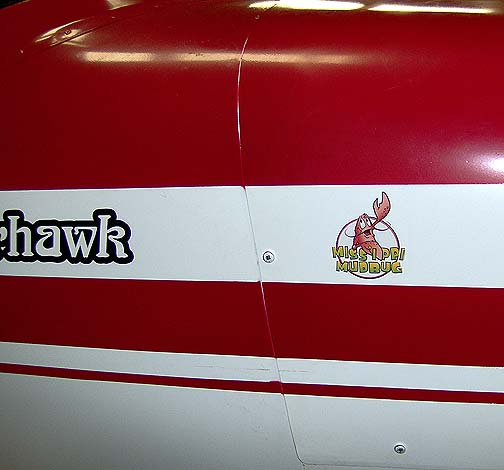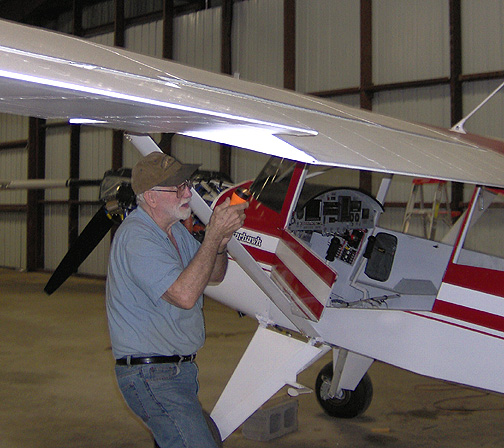
April 27, 2008
Well the airplane is just about complete and it's finally time to have the FAA come and inspect it. I have scheduled an inspection with DAR (Designated Airworthiness Representative) John Moeller for May 10, 2008. John will go over all of the paperwork with me, thoroughly inspect the airplane and if all goes well, he will issue me an airworthiness certificate (with flight restrictions for a certain number of hours while in phase1 test flying).
The airplane was stripped of all inspection covers, seats and cowling to allow the inspector to really give it a good look.
I asked my EAA tech counselor Mickey Whittenburg to come take a final look
at the airplane before the official FAA inspection. So Mickey came
over to the Ocean Springs airport and spent some time looking in every nook
and cranny with a flashlight:

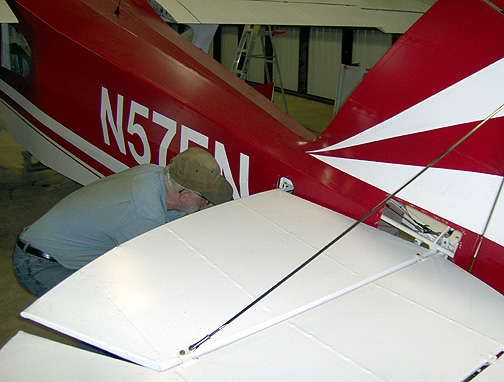
Only a couple of minor things were found. I had one of the flap return springs on cockeyed on the retainers and I needed to secure the wires that run to the starter solenoid a little better. Otherwise, it looked good. I hope John Moeller agrees on May 10th.
May 10, 2008
Well the big day has finally arrived. 4 1/2 years of building has lead to this - the FAA inspection to hopefully earn a Certificate of Airworthiness which allows me to legally fly the Bearhawk.
FAA Designated Airworthiness Representative (DAR) John Moeller showed up at 9:00 AM this morning and after some brief introductions, started an extremely thorough inspection of N57EN. John spent about 2 1/2 hours looking at the airplane, and only about 1/2 hour on the paperwork. Since we had been in contact several times leading up to this inspection, much of the required paperwork was already done.
I think it would be an understatement to say that John looked the airplane over. He took out his flashlight and starting at the engine, looked at ever possible item, wiggled wires, pulled on things, looked into every inspection hole from every possible angle, while having me work the controls back and forth. He poked and prodded, knocked on the wings full length while listening, crawled inside the airplane, rolled under it on a creeper, spent time inside the tail, under the instrument panel, and on a ladder twice, looking at the tops of the wings and at the top of the engine.
Here is John checking out the electric elevator trim system:
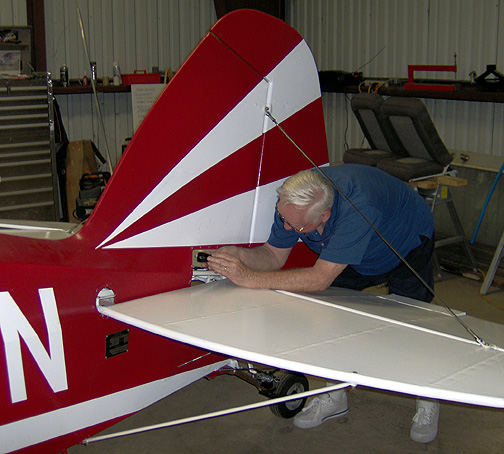
I was extremely happy that John was so thorough. After all, I will be taking friends and family up in this airplane and really wanted him to be as picky as possible. John has over 50 years of experience inspecting all types of aircraft for the FAA. Mickey has over 50 years of experience building them. If you add in all of the other experienced aircraft mechanics, engineers (that's you zippydog) and builders that I've had visit N57EN over the years, I figure that over 200 years of combined experience has looked at this airplane. I feel really good about it.
The following items (mostly recommendations) were pointed out by John:
1. The bolts that hold the carb airbox to the carburetor are short (because they have to be to clear a flange) and by design they are installed with head facing down. John recommends that I install drilled head bolts and safety wire the bolts to each other.
2. The side windshield fairing (where the side window meets the windshield) is tall enough to rub on the windshield at the curve of the windshield that meets the wing shape. This could cause cracking of the windshield. John recommended that I trim it a bit.
3. The hole in the bottom wing skin where the aileron cable enters the wing near the lift strut is too small. The cable is not rubbing, but is very close. John recommended that I open the hole a bit and possibly put a grommet in the hole.
4. The flap cable rubs along the edge of the pulley where it exits the fuselage side near the flap drive arm of the wing. John recommends that I carefully check it at the annual condition inspections.
5. John requested that I label the fuse blocks rather than just using numbers with a note in the POH stating which fuse is which. Too hard to do the research while in flight and change out a fuse if you have to look it up first.
6. Where the firewall forward wires pass through the firewall, on the cabin side, there is a potential for chaffing. John recommends that I put some rubber hose or some sort of protection there to protect the wires. I'm thinking a short piece of 3/8 fuel hose, split and slipped over the wires and then secured with a hose clamp.
7. John recommended that I placard the little computer plug that's under the panel for updating the EFIS and possibly capping it off to prevent dirt from getting in it.
8. He recommended that I put a little sticker near the static ports on the fuselage sides that says "Static Port - Do not paint".
That's it. All good stuff (especially the wires chaffing and the windshield fairing rubbing on the windshield curve). I will take care of the whole list before first flight.
In the end, we spent a bit of time making a few logbook entries and finishing
up some paperwork. He had me read the flight limitations and asked
if I had any questions. Finally, the big moment, I received my Certificate
of Airworthiness:
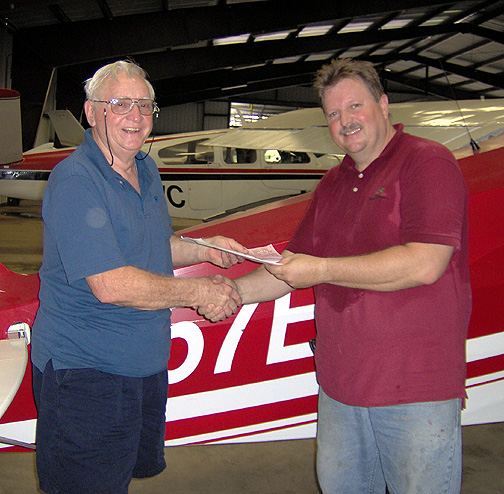
That's it. N57EN is officially an airplane now. Now, I will complete the above list and then reassemble all of the inspection covers, engine cowling, and gap fairings in preparation for first flight.
Now that its an airplane, I can officially put the "Miss'ippi Mudbug" nose
art in place:
